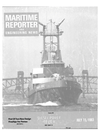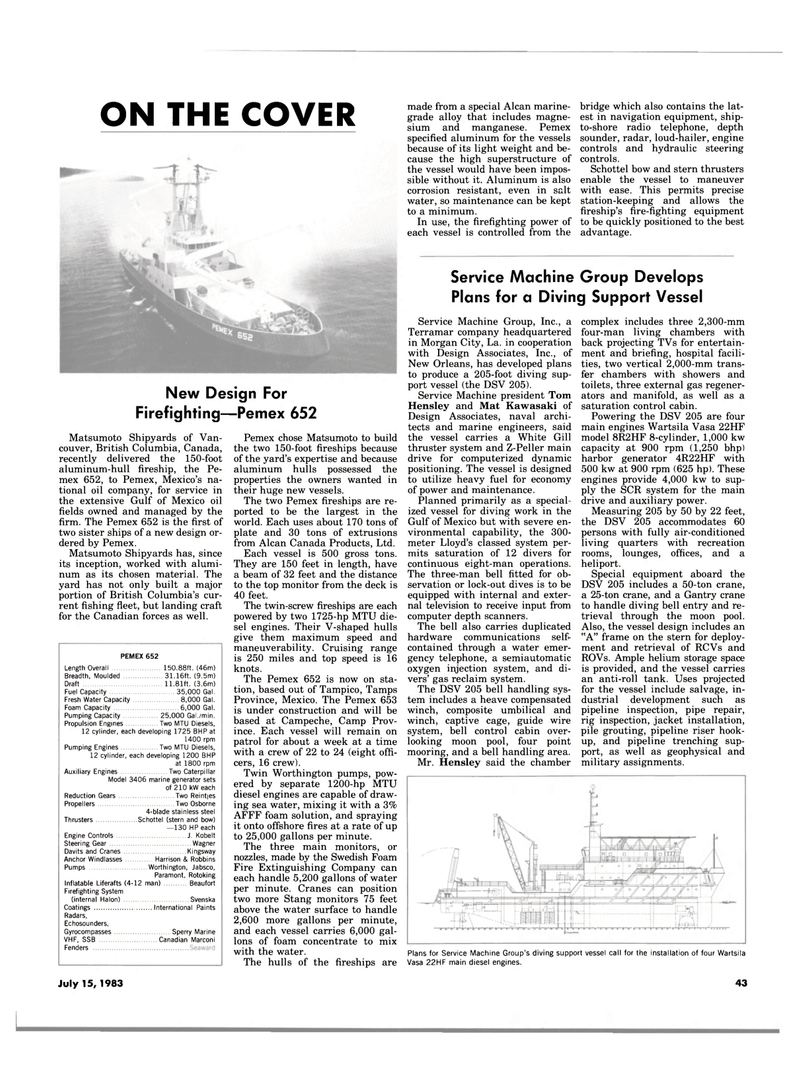
Page 39: of Maritime Reporter Magazine (July 15, 1983)
Read this page in Pdf, Flash or Html5 edition of July 15, 1983 Maritime Reporter Magazine
ON THE COVER
New Design For
Firefighting—Pemex 652
Matsumoto Shipyards of Van- couver, British Columbia, Canada, recently delivered the 150-foot aluminum-hull fireship, the Pe- mex 652, to Pemex, Mexico's na- tional oil company, for service in the extensive Gulf of Mexico oil fields owned and managed by the firm. The Pemex 652 is the first of two sister ships of a new design or- dered by Pemex.
Matsumoto Shipyards has, since its inception, worked with alumi- num as its chosen material. The yard has not only built a major portion of British Columbia's cur- rent fishing fleet, but landing craft for the Canadian forces as well.
PEMEX 652
Length Overall 150.88ft. (46m)
Breadth, Moulded .... 31.16ft. (9.5m)
Draft 11.81ft. (3.6m)
Fuel Capacity 35,000 Gal.
Fresh Water Capacity 8,000 Gal.
Foam Capacity 6,000 Gal.
Pumping Capacity .... 25,000 Gal. min.
Propulsion Engines ... Two MTU Diesels, 12 cylinder, each developing 1725 BHP at 1400 rpm
Pumping Engines Two MTU Diesels, 12 cylinder, each developing 1200 BHP at 1800 rpm
Auxiliary Engines Two Caterpillar
Model 3406 marine generator sets of 210 kW each
Reduction Gears Two Reinties
Propellers Two Osborne 4-blade stainless steel
Thrusters .Schottel (stern and bow) —130 HP each
Engine Controls J. Kobelt
Steering Gear Wagner
Davits and Cranes .... Kingsway
Anchor Windlasses .... Harrison & Robbins
Pumps Worthington, Jabsco,
Paramont, Rotoking
Inflatable Liferafts (4-12 man) Beaufort
Firefighting System (internal Halon) .... Svenska
Coatings International Paints
Radars,
Echosounders,
Gyrocompasses Sperry Marine
VHF, SSB Canadian Marconi
Fenders made from a special Alcan marine- grade alloy that includes magne- sium and manganese. Pemex specified aluminum for the vessels because of its light weight and be- cause the high superstructure of the vessel would have been impos- sible without it. Aluminum is also corrosion resistant, even in salt water, so maintenance can be kept to a minimum.
In use, the firefighting power of each vessel is controlled from the bridge which also contains the lat- est in navigation equipment, ship- to-shore radio telephone, depth sounder, radar, loud-hailer, engine controls and hydraulic steering controls.
Schottel bow and stern thrusters enable the vessel to maneuver with ease. This permits precise station-keeping and allows the fireship's fire-fighting equipment to be quickly positioned to the best advantage.
Pemex chose Matsumoto to build the two 150-foot fireships because of the yard's expertise and because aluminum hulls possessed the properties the owners wanted in their huge new vessels.
The two Pemex fireships are re- ported to be the largest in the world. Each uses about 170 tons of plate and 30 tons of extrusions from Alcan Canada Products, Ltd.
Each vessel is 500 gross tons.
They are 150 feet in length, have a beam of 32 feet and the distance to the top monitor from the deck is 40 feet.
The twin-screw fireships are each powered by two 1725-hp MTU die- sel engines. Their V-shaped hulls give them maximum speed and maneuverability. Cruising range is 250 miles and top speed is 16 knots.
The Pemex 652 is now on sta- tion, based out of Tampico, Tamps
Province, Mexico. The Pemex 653 is under construction and will be based at Campeche, Camp Prov- ince. Each vessel will remain on patrol for about a week at a time with a crew of 22 to 24 (eight offi- cers, 16 crew).
Twin Worthington pumps, pow- ered by separate 1200-hp MTU diesel engines are capable of draw- ing sea water, mixing it with a 3%
AFFF foam solution, and spraying it onto offshore fires at a rate of up to 25,000 gallons per minute.
The three main monitors, or nozzles, made by the Swedish Foam
Fire Extinguishing Company can each handle 5,200 gallons of water per minute. Cranes can position two more Stang monitors 75 feet above the water surface to handle 2,600 more gallons per minute, and each vessel carries 6,000 gal- lons of foam concentrate to mix with the water.
The hulls of the fireships are
Service Machine Group Develops
Plans for a Diving Support Vessel
Service Machine Group, Inc., a
Terramar company headquartered in Morgan City, La. in cooperation with Design Associates, Inc., of
New Orleans, has developed plans to produce a 205-foot diving sup- port vessel (the DSV 205).
Service Machine president Tom
Hensley and Mat Kawasaki of
Design Associates, naval archi- tects and marine engineers, said the vessel carries a White Gill thruster system and Z-Peller main drive for computerized dynamic positioning. The vessel is designed to utilize heavy fuel for economy of power and maintenance.
Planned primarily as a special- ized vessel for diving work in the
Gulf of Mexico but with severe en- vironmental capability, the 300- meter Lloyd's classed system per- mits saturation of 12 divers for continuous eight-man operations.
The three-man bell fitted for ob- servation or lock-out dives is to be equipped with internal and exter- nal television to receive input from computer depth scanners.
The bell also carries duplicated hardware communications self- contained through a water emer- gency telephone, a semiautomatic oxygen injection system, and di- vers' gas reclaim system.
The DSV 205 bell handling sys- tem includes a heave compensated winch, composite umbilical and winch, captive cage, guide wire system, bell control cabin over- looking moon pool, four point mooring, and a bell handling area.
Mr. Hensley said the chamber complex includes three 2,300-mm four-man living chambers with back projecting TVs for entertain- ment and briefing, hospital facili- ties, two vertical 2,000-mm trans- fer chambers with showers and toilets, three external gas regener- ators and manifold, as well as a saturation control cabin.
Powering the DSV 205 are four main engines Wartsila Vasa 22HF model 8R2HF 8-cylinder, 1,000 kw capacity at 900 rpm (1,250 bhp) harbor generator 4R22HF with 500 kw at 900 rpm (625 hp). These engines provide 4,000 kw to sup- ply the SCR system for the main drive and auxiliary power.
Measuring 205 by 50 by 22 feet, the DSV 205 accommodates 60 persons with fully air-conditioned living quarters with recreation rooms, lounges, offices, and a heliport.
Special equipment aboard the
DSV 205 includes a 50-ton crane, a 25-ton crane, and a Gantry crane to handle diving bell entry and re- trieval through the moon pool.
Also, the vessel design includes an "A" frame on the stern for deploy- ment and retrieval of RCVs and
ROVs. Ample helium storage space is provided, and the vessel carries an anti-roll tank. Uses projected for the vessel include salvage, in- dustrial development such as pipeline inspection, pipe repair, rig inspection, jacket installation, pile grouting, pipeline riser hook- up, and pipeline trenching sup- port, as well as geophysical and military assignments.
Plans for Service Machine Group's diving support vessel call for the installation of four Wartsila
Vasa 22HF main diesel engines.
July 15, 1983 43

 38
38

 40
40
